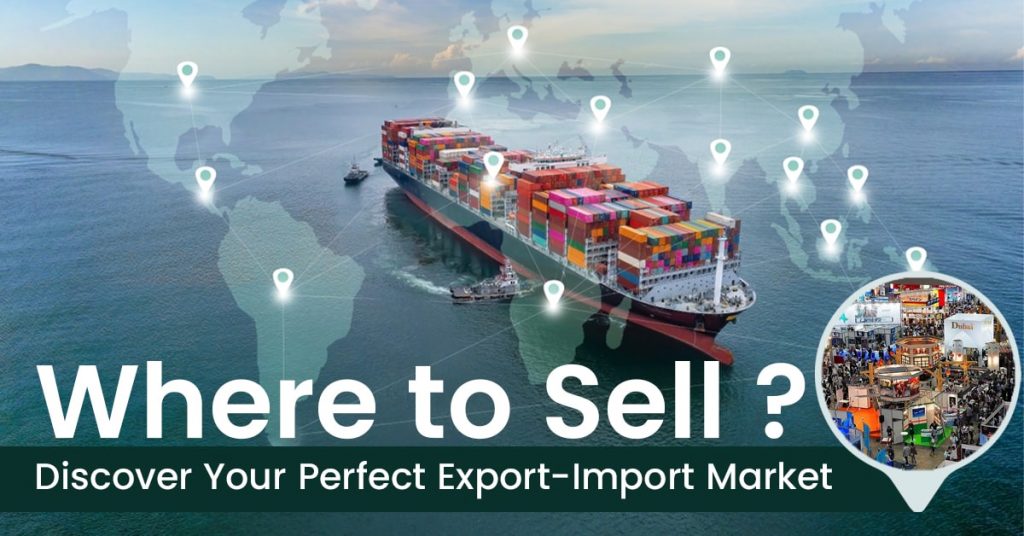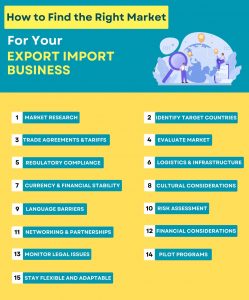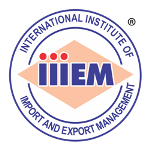
In the dynamic world of international trade, choosing the right market for your export-import business is a strategic decision that requires careful consideration of various factors. Whether you are a seasoned exporter looking to expand your reach or a newcomer exploring global opportunities, the success of your venture hinges on selecting the right market.
In this comprehensive guide, we’ll delve into the key aspects that should shape your decision-making process.
1. Market Research:
Before embarking on any international venture, a solid foundation of market research is essential. Begin by understanding global economic trends and forecasts. A thorough analysis of potential markets for your specific products or services is critical. Look at market size, growth potential, and existing competition. Tools like market research reports, industry publications, and trade associations can provide valuable insights.
2. Identifying Target Countries:
Once informed by global insights, narrow down your focus to specific countries. Consider factors such as political stability, economic conditions, and legal regulations. Political stability ensures a secure environment for your business operations, while economic conditions directly impact consumer purchasing power. Familiarize yourself with the legal landscape of the target country to ensure compliance with regulations governing your industry.
3. Trade Agreements and Tariffs:
Explore existing trade agreements between your country and the target market. These agreements can significantly impact the ease of doing business and reduce trade barriers. Additionally, be aware of import/export tariffs and restrictions that may affect your business. Stay informed about changes in trade policies to adapt your strategy accordingly.
4. Evaluate Market:
Understanding the demand for your products or services in the target market is crucial. Conduct a thorough analysis of the competition, identifying key players and market gaps. Assessing demand and competition helps you tailor your offerings to meet the specific needs of the market, giving you a competitive edge.
5. Regulatory Compliance:
Every market has its own set of regulations and standards. Ensure that your products meet local standards and regulations. Neglecting these standards may cause significant delays and setbacks. Invest time in understanding and meeting the regulatory requirements of the target market, seeking legal counsel if necessary.
6. Logistics and Infrastructure:
Logistics plays a crucial role in the success of an export-import business. Assess the logistical feasibility of transporting goods to and from the market. Consider the quality of infrastructure, including transportation and communication. A well-developed logistical plan ensures timely delivery of goods and enhances overall operational efficiency.

7. Currency and Financial Stability:
Evaluate the stability of the local currency and financial system. Consider currency exchange rates and potential financial risks. Fluctuations in currency values can impact your profit margins and overall financial stability. Implement risk mitigation strategies and, if necessary, work with financial experts to navigate currency-related challenges.
8. Cultural Considerations:
Cultural differences can significantly influence consumer behavior. Adapt your marketing and business approach to align with the local culture. Understanding the preferences and expectations of the target audience allows you to tailor your products and marketing messages effectively. Learn about their local culture to foster positive relationships with consumers in the new market.
9. Language Barriers:
Address potential language barriers by providing translations and localized support. Ensure that product labeling and documentation are in the local language. Effective communication is essential for building trust with consumers and navigating business transactions smoothly.
10. Risk Assessment:
Identify potential risks such as political instability, currency fluctuations, and market volatility. Develop risk mitigation strategies to safeguard your business. Conduct a thorough risk assessment, and have backup plans in place to respond swiftly to unforeseen challenges. Flexibility and preparedness are keys in the unpredictable landscape of international business.
11. Networking and Partnerships:
Building relationships with local partners, distributors, and government authorities is invaluable. Local partners can provide insights into market dynamics and help navigate local customs and behaviors. Establishing strong partnerships enhances your market presence and opens doors to opportunities that might be challenging to access independently.
12. Financial Considerations:
Estimate the costs associated with entering and operating in the chosen market. Create a realistic budget and financial plan for your global growth—factor in expenses such as marketing, logistics, compliance, and local partnerships. A well-thought-out financial plan ensures that your business is adequately funded for sustainable growth.
13. Monitor Legal Issues:
Stay updated about any legal changes or developments that may affect your business. Get advice from legal experts to make sure you’re following all the rules and laws. Regularly monitor legal issues in the target market and be proactive in adapting your business practices to stay within the legal framework.
14. Pilot Programs:
Try testing the market with a small-scale pilot program. This allows you to gather real-time feedback, identify challenges, and make necessary adjustments before fully committing to the market. Pilot programs provide valuable insights that can inform your strategic decisions and increase the likelihood of long-term success.
15. Stay Flexible and Adaptable:
In the ever-evolving landscape of international trade, adaptability is key. Be prepared to adjust your strategy based on evolving market conditions. Stay informed about changes in the global business landscape, economic trends, and geopolitical developments. Flexibility allows your business to thrive in dynamic and uncertain environments.
Choosing the right market for your import-export business is a complex task that needs a thorough approach. Consider important factors like market research, stability in economics and politics, following rules, understanding different cultures, and financial aspects. Making well-informed decisions in these areas is key to a successful global expansion.
Remember that each market is different, so a personalized strategy is necessary for long-term growth and success worldwide. If you want to learn more about import-export, check out iiiEM’s top Import-Export Certification Courses. They provide essential knowledge and skills for a successful international business journey.
